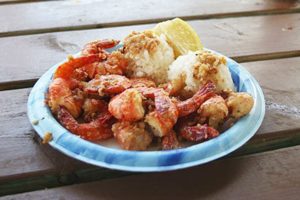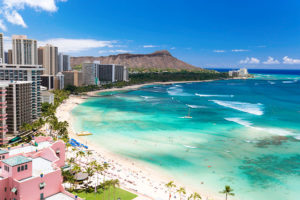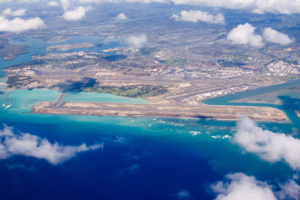Oahu, nicknamed “The Gathering Place,” is a fitting moniker for the influx of drivers here, especially along the roads of Honolulu. Gathered here are some basic driving rules and tips as you Hele On!
BASIC RULES
Those accustomed to leaning to the left when behind the wheel, are reminded that here in the United States, traffic rumbas to the right. The minimum (fully licensed) driving age in Hawaii is 17 years old, and all drivers must possess a valid U.S. or International driver’s license when operating a vehicle.
Hawaii speed limits and traffic rules are strictly enforced, with signs posted and easily visible throughout the city. Seat belts are to be worn at all times within private vehicles, although you will still likely see many-a local in defiance of said state law, riding “island-style” (sans straps), sardined into the back of a pickup.
A right turn on a red light after stopping is permitted unless otherwise indicated (just use extra caution, especially when cruising near Waikiki’s pedestrian-riddle crosswalks—pedestrians have the right of way at any intersection, and believe us, they will take it).
The legal drinking age in Hawaii is 21 years old, and those driving under the influence of alcohol or drugs will be arrested.
CELL PHONES
Hawaii law requires all drivers to use a hands-free device when talking on a cell phone while driving—GPS or mapping services are permitted.
CHILD SAFETY
Hawaii state law requires that all children wear seat belts, with those weighing less than 50 pounds secured in a child safety or booster seat.
PARKING
Parking space in Honolulu is scarce, particularly during the day. And although there is metered parking available, your best bet is to find a paid parking garage. Many restaurants and shopping centers also offer valet parking for a fee, or even validate parking with a purchase.
Vehicles parked in violation of posted regulations are ticketed and towed almost immediately, so be sure to carefully read all signs. Color cues for parking —painted on curbs—also abound. Note that: Red means “no,” green means “go,” but only for a limited time, and white or yellow means passenger loading/unloading only.
TRAFFIC
Rush-hour traffic (6 a.m. to 8:30 a.m. and 3:30 p.m. to 6 p.m.) can be a bear, particularly along the H1 Freeway and Nimitz Highway, going into or out of downtown and Waikiki. Also, Honolulu has many one-way streets, so it is essential to pay close attention to all posted signs.
Should you miss a sign and get lost, friendly locals are always ready to provide you with directions, just note that some of the local jargon may not compute: “makai” means toward the ocean, “mauka” means toward the mountains, “Diamond Head” means toward Diamond Head, and “ewa” is moving away from Diamond Head.
Lastly, there is no need to use your horn here in Honolulu! Honks are reserved for emergencies mostly, and you’ll likely see many-a bumper sticker reminding you to “Relax!!! This ain’t the Mainland!” So happy travels, and drive safe!








